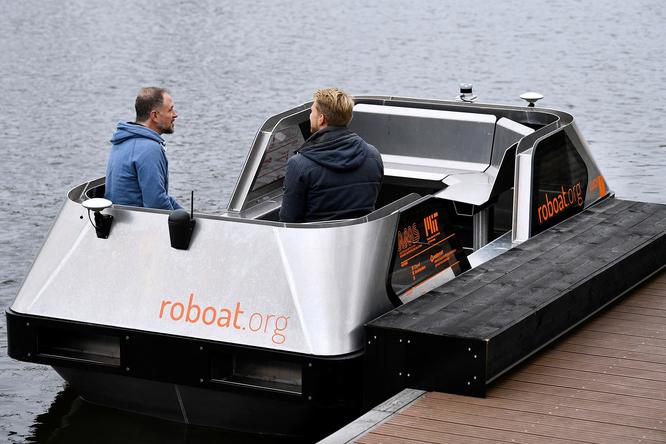Photo courtesy of MIT CSAIL.
The autopilot Roboat project jointly developed by the Massachusetts Institute of Technology (MIT) and the Netherlands' Amsterdam Institute for Advanced Metropolitan Solutions (AMS Institute) has finally ushered in its final chapter. Since the prototype was tested at the Massachusetts Institute of Technology Swimming Pool in 2015, a full-scale, fully autonomous boat has finally appeared on the canal in Amsterdam on October 28, 2021.
The latest Roboat, made of 4000 x 2000 mm aluminum, is emblazoned with orange on the black and gray hull. The opposite seat configuration, 5 people can go on board, do not need a crew. It is reported that the hull is a general design for the generalization of the foundation, and the top part can be replaced according to the purpose. In addition to the battery can sail for up to 10 hours, it also supports wireless charging.

In order to navigate smoothly on the crowded waterway, a careful integration of correct operation instructions, recognition ability and control software is needed. The Roboat is equipped with GPS, LiDAR and computer vision to determine a safe route to avoid obstacles while scanning the surrounding area. If what is not registered in the system is reflected, once it is classified as "unknown", people later confirm the data and mark it as "canoe".
The latch mechanism is also one of the specialties. The camera on the Roboat reads the QR codes of other Roboat and docking stations, the robot arm on the side of the boat grasps each other tightly, and the mechanical brake locks the arm. This time, new functions such as the proximity mode of the latch mechanism and the improvement of the automatic position holding device can be carried out to the actual waterway. Through interconnection, not only offshore operations can be used, but also infrastructure such as temporary pontoons can be used.
"Roboat can be used all year round without a captain, so it will bring huge added value to the city. However, it is a question whether it is best to achieve A-level self-discipline for safety reasons, "said the Fabio Duarte lead researcher." In order to operate smoothly, it is envisaged that the manipulator will be deployed in the control center to monitor more than 50 small boats per person.
The next step is to take measures for experimental application and commercial use. The research team said that the canal, which is finely covered with Amsterdam's historic area, has mobility and logistics challenges, so it is most suitable for introduction. It is expected to make use of human transport, the handling of goods, garbage collection, temporary bridges and stage construction, etc.
Related links:
One autonomous taxi,pleaseRoboatMIT, the development of interconnected self-driving robot ship "Roboat" MIT autopilot ship, human handling success






![[New Toyota Voxy (90 series)] Amplifies the characteristics of the aero body! A design that further enhances the power of the front mask! #Works direct custom deep layer 001](https://website-google-hk.oss-cn-hongkong.aliyuncs.com/drawing/article_results_9/2022/3/25/01568e2fbf021c0eaf7d013507c850a4_0.jpeg)

![[Toyota Noah / Voxy new model] Modellista releases various customized parts ... Actual vehicle exhibited at Tokyo Auto Salon](https://website-google-hk.oss-cn-hongkong.aliyuncs.com/drawing/article_results_9/2022/3/25/8268612c1e5941e62d3dfd07f8991b2f_0.jpeg)
